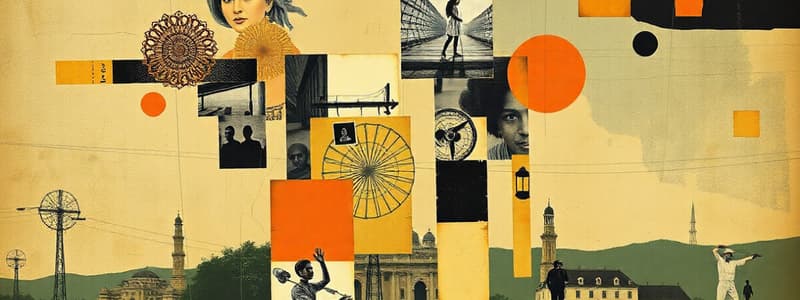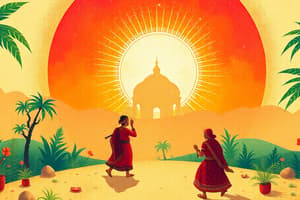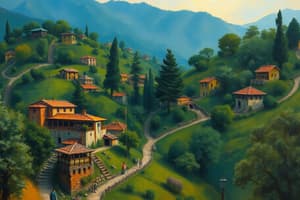Podcast
Questions and Answers
Which of the following is NOT a key influence on the diversity of Indian arts and culture?
Which of the following is NOT a key influence on the diversity of Indian arts and culture?
- Unique traditions
- Interactions with other civilizations
- Influence of European colonialism (correct)
- Long history
What is a defining characteristic of many Indian art forms?
What is a defining characteristic of many Indian art forms?
- Focus on realistic depiction
- Emphasis on abstract concepts
- Prevalence of Western artistic techniques
- Integration of spiritual and philosophical themes (correct)
Which period saw the development of Mughal miniature painting?
Which period saw the development of Mughal miniature painting?
- Ancient Period
- Medieval Period (correct)
- Modern Period
- None of the above
What is a characteristic feature of Indian classical music forms like Hindustani and Carnatic?
What is a characteristic feature of Indian classical music forms like Hindustani and Carnatic?
Which of the following is NOT a classical dance form of India?
Which of the following is NOT a classical dance form of India?
What is a key theme explored in the epics Ramayana and Mahabharata?
What is a key theme explored in the epics Ramayana and Mahabharata?
Which of the following best describes the influence of Western art on Indian art during the Modern period?
Which of the following best describes the influence of Western art on Indian art during the Modern period?
What distinguishes Tanjore painting from other Indian painting styles?
What distinguishes Tanjore painting from other Indian painting styles?
How do Indian arts and crafts reflect cultural heritage?
How do Indian arts and crafts reflect cultural heritage?
What aspect of Indian arts and crafts highlights the cultural significance of specific materials and techniques?
What aspect of Indian arts and crafts highlights the cultural significance of specific materials and techniques?
What is the primary way that Indian arts and culture connect people to their heritage?
What is the primary way that Indian arts and culture connect people to their heritage?
Which of the following is NOT a characteristic of Indian arts and crafts?
Which of the following is NOT a characteristic of Indian arts and crafts?
What significance do Indian arts and crafts hold in the context of cultural continuity?
What significance do Indian arts and crafts hold in the context of cultural continuity?
Flashcards
Diversity of Indian Arts
Diversity of Indian Arts
Indian arts and culture reflect a long history and various influences across different forms like painting, sculpture, music, and literature.
Ancient Period Influences
Ancient Period Influences
This period features early art forms influenced by Buddhism and Hinduism, including Indus Valley artifacts.
Medieval Art Contributions
Medieval Art Contributions
Rajput, Mughal, and Vijayanagara dynasties advanced art, including miniature painting and architecture.
Modern Period of Indian Art
Modern Period of Indian Art
Signup and view all the flashcards
Miniature Paintings
Miniature Paintings
Signup and view all the flashcards
Classical Indian Music
Classical Indian Music
Signup and view all the flashcards
Classical Dance Forms
Classical Dance Forms
Signup and view all the flashcards
Indian Literary Epics
Indian Literary Epics
Signup and view all the flashcards
Indian Literature
Indian Literature
Signup and view all the flashcards
Indian Architecture
Indian Architecture
Signup and view all the flashcards
Arts and Crafts
Arts and Crafts
Signup and view all the flashcards
Cultural Significance
Cultural Significance
Signup and view all the flashcards
Symbolism in Crafts
Symbolism in Crafts
Signup and view all the flashcards
Study Notes
Indian Arts and Culture - Overview
- Indian arts and culture are diverse and rich, reflecting the country's long history and various influences.
- They encompass a wide range of artistic expressions, including painting, sculpture, music, dance, literature, and architecture.
- The diverse cultural landscape of India is shaped by its long history of interactions with other civilizations and its unique traditions.
- Indian art forms often incorporate spiritual and philosophical themes interwoven with daily life.
- Various regional styles and traditions contribute to the overall tapestry of Indian art and culture.
Key Periods and Influences
- Ancient Period (Pre-historic to Medieval): This period showcases early forms of art, such as Indus Valley Civilization artifacts and rock-cut architecture. Influences from Buddhism and Hinduism are evident in sculptures and paintings.
- Medieval Period (various dynasties): Significant contributions came from the Rajput, Mughal, and Vijayanagara schools of art. This period saw advancements in miniature painting, architecture (forts, palaces), and musical traditions.
- Modern Period (1800-present): Western influences blended with traditional styles to create new artistic expressions. Indian artists began incorporating modern techniques into their works, alongside exploring themes of national identity.
Artistic Expressions - Specific Examples
- Painting: Miniature paintings, murals, and contemporary works, exhibiting various styles like Mughal, Rajput, and Tanjore painting. Each style reflects the prevailing social values and historical contexts of the time period.
- Sculpture: Stone sculptures, bronze castings, and terracotta figures showcasing religious and mythological scenes. The emphasis on form, expression and narrative is apparent in all works.
- Music: Classical music forms such as Hindustani and Carnatic, featuring distinct rhythmic patterns, melodic structures, and vocal traditions. Folk/regional musical styles are equally integral to Indian culture, expressing the spirit of local communities.
- Dance: Classical dance forms such as Bharatanatyam, Kathak, Odissi, and Mohiniyattam, emphasizing precise steps, graceful movements, and storytelling through body language and costumes. Ritualistic folk dances and tribal dance forms remain highly important.
- Literature: Epics like the Ramayana and Mahabharata have shaped Indian culture. These works demonstrate storytelling, philosophical views, and diverse themes. Different languages and genres have contributed to Indian literature, including poetry, novels, plays, and more.
- Architecture: Temples, palaces, forts (like the Taj Mahal, Red Fort) and other structures exemplify the skillfulness of Indian builders. The utilization of materials, architectural styles, and construction techniques vary across regions, demonstrating the ingenuity of artisans.
Arts and Crafts - Details
- Indian arts and crafts are often closely tied to daily life and traditions. This includes weaving, pottery, metalwork, and embroidery, reflecting the cultural heritage of distinct communities and skillsets.
- These crafts demonstrate a high degree of manual dexterity, intricate design, and attention to detail.
- The use of specific materials and techniques often holds symbolic or cultural significance.
Cultural Significance
- Indian arts and culture provide a window into the country's history, values, and traditions.
- They offer insights into the spiritual and philosophical beliefs of different communities.
- Diverse styles and traditions demonstrate the rich tapestry of Indian society.
- Arts and crafts enrich Indian life, connecting people to their heritage, community, and values.
- These artistic expressions foster a sense of pride and continuity across generations.
Studying That Suits You
Use AI to generate personalized quizzes and flashcards to suit your learning preferences.




